_We may earn revenue from the products available on this page and participate in affiliate programs. Learn more ›
_
Best for Sand
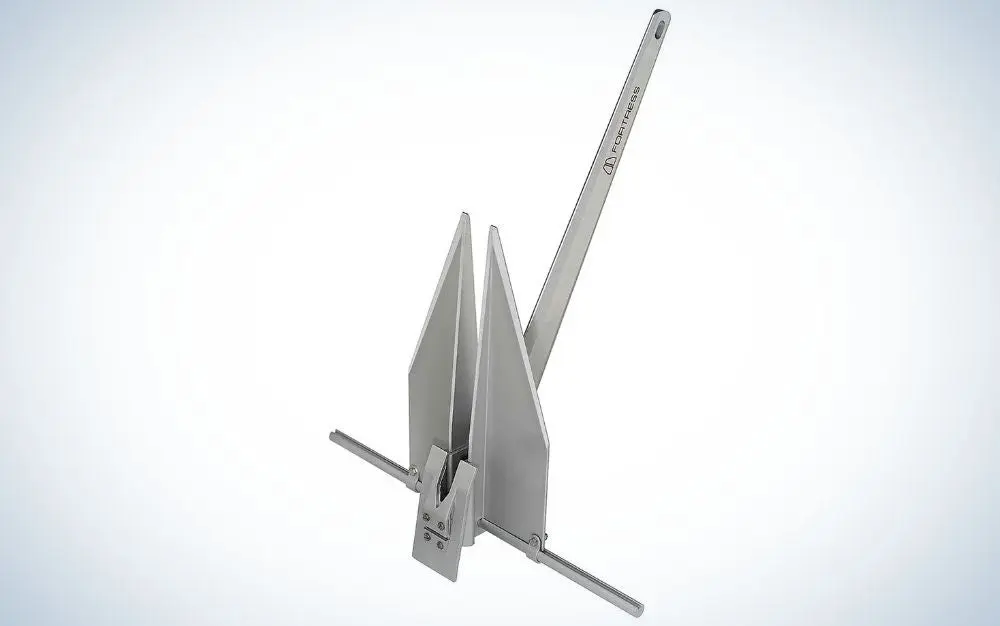
Fortress Danforth Anchor
LEARN MORE
Summary
It’s strong, with very sharp flukes that dig into sand. Aluminum/magnesium construction means it’ll never rust.
Best for Rivers
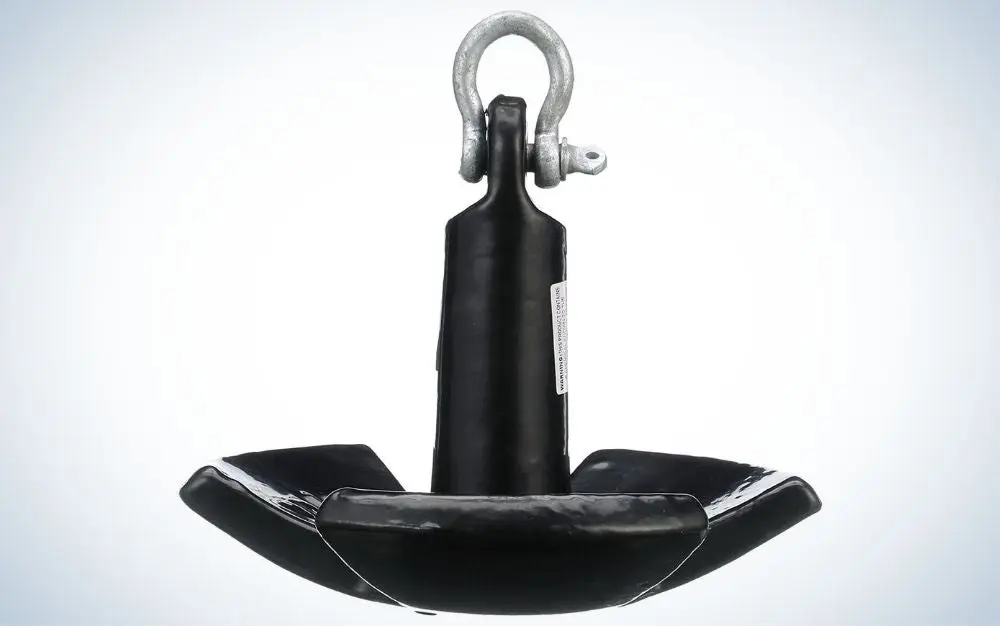
Seachoice 41500 River Anchor
LEARN MORE
Summary
The modified mushroom style holds firmly in current but resists getting stuck. The vinyl coating protects against corrosion.
Best for Rocky Bottoms
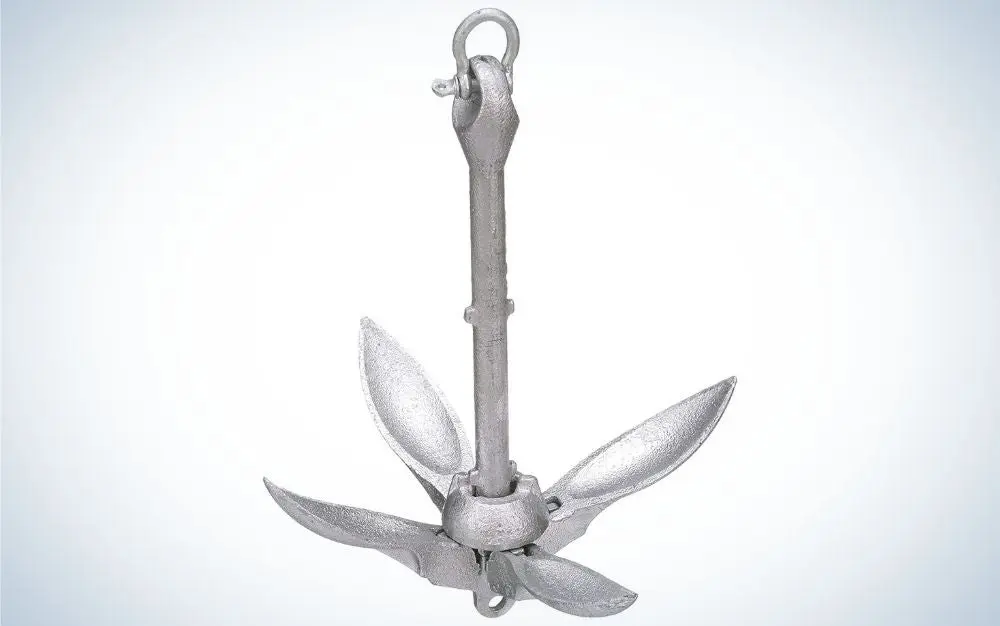
Seachoice Grapnel Anchor
LEARN MORE
Summary
Four flukes allow good bottom penetration. The flukes fold up, allowing the anchor to work well on rocky bottoms.
A boat anchor is one of the most important accessories on any boat. Not only does a boat anchor hold the boat in one position for docking and fishing, but it can prevent a bad situation from becoming worse if the boat loses power. The most common type of anchor for most boats is a danforth or fluke anchor. This anchor features two sharp blades that stick into sandy or muddy bottoms. For rocky a bottom or structure, anglers choose a mushroom anchor with a wide, heavy head that holds the boat in place. Kayak and canoe anglers prefer a collapsable grapple anchor that folds up to save space. To pull the boat up on a sandbar and join the party, boaters prefer a spike anchor that sticks into the sand to keep the boat in place without causing a tripping hazard. No matter your activity, the best anchor is essential for docking, fishing, and safety.
Best for Sand: Fortress Danforth Anchor
Best for Rocky Bottom: Seachoice Grapnel Anchor
Best for Rivers: Seachoice 41500 River Anchor
Best for Mud: YakAttack Two-Piece ParkNPole
Best for Sandbars: Slide Anchor Spike
How We Picked the Best Boat Anchors
We compared various anchors based on their performance in specific categories. The most being how well the anchor holds the boat in place in wind, waves, and current. Next, we evaluated build quality by looking at materials and construction. An anchor takes a beating, so we favored corrosion-resistant metals and sturdy components and connections. We also considered what each anchor’s intended use was.
Best Boat Anchors: Reviews and Recommendations
Best for Sand: Fortress Danforth Anchor
Best for Sand

Specs
Weight: 4.8 pounds
Dimensions: 25”X5”X3”
Materials: Anodized Aluminum
Pros
Light, anodized aluminum
Corrosion resistant
Sharpened flukes
Cons
Expensive
A danforth or fluke anchor uses two sharp blades that will insert themselves into soft bottom. To work properly, a fluke anchor is attached to a length of chain and an anchor rope. As the anchor drags across the bottom, the heavy chain forces the anchor shaft down and pushes the flukes into the bottom. To remove the anchor, retrieve the rope until you can lift the anchor shaft up, and pull the flukes out of the bottom.
A common misconception is that a danforth anchor has to be heavy to hold the boat. But, since the flukes are what holds the boat in place, not the anchor weight, super strong and sharp flukes are what matters. The Fortress Anchor is made of anodized aluminum and magnesium, which is lighter and more corrosion-resistant than similar galvanized steel anchors. In tests, the Fortress Anchor was able to hold more weight with a smaller, lighter anchor. In addition to the lightest and toughest material, the Fortress Anchor uses sturdy construction to hold boats from 16 to 27 feet long in strong currents and heavy seas.
Best for Rocky Bottom: Seachoice Grapnel Anchor
Best for Rocky Bottom

Specs
Weight: 1.5 pounds to 9 pounds
Dimensions: 4 ¾” x 6 ¾”
Materials: Galvanized iron
Pros
Folding flukes
Can also be used on rocky bottoms or in mud
Inexpensive
Cons
Galvanized iron can eventually rust
The Seachoice grapnel anchor features four flukes and a shaft with a locking ring. When it’s not in use, the four flukes fold flat against the shaft for easy storage in a small boat. On a soft or muddy bottom, unfold the flukes and lock them in place, so they stick in the bottom. To use the anchor on rocky or hard bottom, leave the flukes folded and use the weight of the anchor to hold the boat. Keeping the flukes folded prevents the anchor from getting stuck in rocks.
The Seachoice grapnel anchor has a clevis link to attach the anchor rope. For deeper water or a heavier boat, add a short length of light chain to help drive the flukes into the bottom. For a small kayak or canoe in light current, a 1.5-pound grapnel anchor will suffice. A skiff or dinghy requires a heavier nine-pound grapnel anchor. Grapnel anchors aren’t appropriate for anchoring a boat unattended, because the flukes can pull out of the bottom.
Best for Rivers: Seachoice 41500 River Anchor
Best for Rivers

Key Features
Weight: 12 pounds
Dimensions: 8”X9.5”
Materials: Vinyl coated iron
Pros
Heavy, vinyl coated iron
Galvanized shackle included
Modified mushroom anchor grips hard bottoms
Cons
Not corrosion resistant
For anchoring a small boat in swift water with a hard bottom, the weight and rounded shape of a mushroom anchor holds the bottom without getting stuck. The Seachoice 41500 River Anchor improves on the traditional mushroom anchor. The head of the mushroom is notched to better grip the bottom. The anchor is made of heavy iron with a vinyl coating to prevent corrosion.
Using Seachoice 41500 is easy. Just attach a rope to the included galvanized shackle and drop the anchor in the water. The anchor is designed to slip free under high pressure, making it the safest and best river anchor.
Best Kayak Anchor for Mud: YakAttack Two-Piece ParkNPole
Best Kayak Anchor for Mud
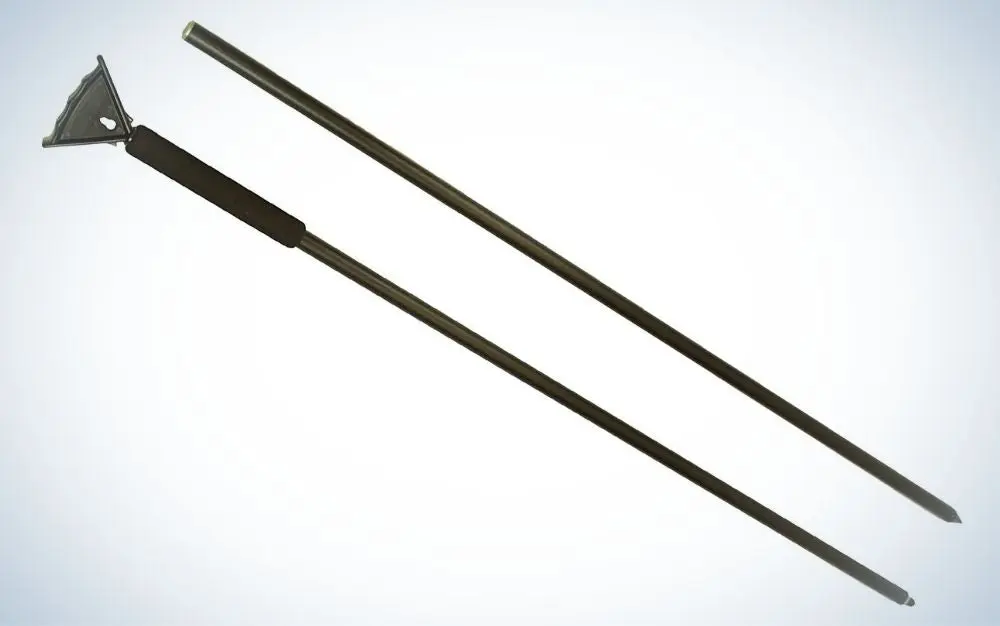
Specs
Weight: 1.8 pounds
Dimensions: 8 feet long
Materials: Fiberglass and reinforced plastic
Pros
Two-piece for easy storage
Tough UV stabilized fiberglass
Hardened spike for anchoring
Cons
Takes up space on the deck
For anchoring in soft sand or mud, a stakeout pole is the best kayak anchor for mud and is quick and easy to deploy and retrieve. Simply stick the pole in the bottom and secure the boat with a short line. To retrieve the anchor, pull it from the mud and store it on the deck. YakAttack’s ParkNPole has been a standard for shallow-water anglers in saltwater and freshwater. The two-piece model makes it easier to store the pole inside a kayak or in an under-deck rod holder.
The fiberglass shaft is tough and light while providing flex to absorb the shock of the boat pulling against the pole. The hardened pointed tip easily pierces the bottom for a solid grip. Flip the ParkNPole over, and the wide, reinforced plastic foot makes it a convenient push pole. The advantage of the stakeout pole is stopping the boat quickly to make a cast. Then, pull up the stakeout pole, flip it over and push to the next spot.
Best for Sandbars: Slide Anchor Spike
Best for Sandbars
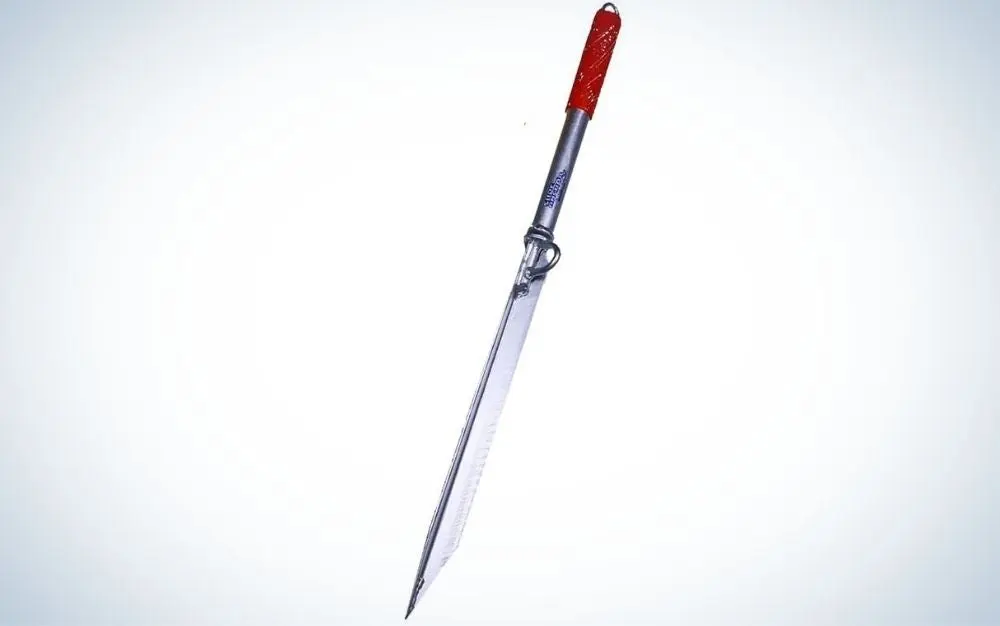
Specs
Weight: 2 Pounds
Dimensions: 32” x 3.2” x 3.2”
Materials: Galvanized steel
Pros
Galvanized for corrosion resistance
High visibility for safety
Secure connections
Cons
Bungee cord secures driver
The Slide Anchor Spike is the best boat anchor for sandbars. It uses a heavy sliding handle to hammer the spike into the sand. Place the tip of the spike a few inches into the sand, then slide the tubular handle against the stop to drive the spike into the ground. Clip the anchor line to the lower ring on the spike and use the top ring for a buoy or flag to mark the spike’s location. Since the line and the spike are above ground level, Slide Anchor is easier for people to see, while providing a solid anchoring point for the boat.
What to Consider When Choosing a Boat Anchor
Before buying a boat anchor, consider how it will be used and the build quality. A boat anchor is one of the most important boating accessories. Your boat anchor is responsible for securing the boat in any condition. To choose the best boat anchor, consider these questions.
Location and Bottom Composition
Consider the bottom composition before choosing a boat anchor. Anchoring in soft sand or mud is best with a danforth or fluke anchor that digs into the bottom. To anchor in a river, a heavy mushroom anchor will hold the boat without getting stuck in the rocks. If you anchor often while fishing shallow water, a stakeout pole is a quick and effective way to anchor a small boat. A grapnel anchor is adjustable for either soft or hard bottom. Beaching the boat on a sandbar requires a spike-style anchor that sticks into the sand, so it is easier to see.
Size
A large boat requires a danforth anchor with long, wide flukes and a long chain to ensure that the anchor lays on its side, allowing the flukes to dig into the bottom. The chain should be equal to the length of the boat and the same diameter as the anchor rope. Use rope ⅛-inch thick for every nine feet of boat, so ¼-inch rope will hold an 18-foot boat. Carry enough anchor line to equal at least three times the deepest water you plan to fish. Mushroom anchors come in sizes and weights to match smaller boats.
For kayaks and canoes, a grapnel anchor will secure the boat in heavy currents. A smaller grapnel may be appropriate for lakes and ponds, while rivers or tidal passes call for a larger, heavier anchor. Sand spikes come in small and large sizes to match the size of the boat. To anchor a large boat, use two spikes.
Materials
Look for an anchor that is corrosion-resistant. Aluminum will not rust, and stainless steel is very rust-resistant. Heavy anchors made of iron or steel should be galvanized or coated in vinyl. Connections and hinges should be oversized and sturdy to take a beating. Don’t forget shackles and links to connect the anchor to a chain or rope.
FAQs
Q: How much does an anchor cost?
Anchor cost depends on the size and quality of the anchor. Larger anchors cost more than smaller ones, but size isn’t all that affects the cost. Boat anchors vary in build and materials. A more expensive anchor may have tougher construction to last longer. Boat anchors take a lot of abuse, so an anchor with corrosion-resistant materials and heavy-duty components will cost more. Part of boating is losing an anchor. Despite best efforts, broken lines and weakened components will lead to replacing an anchor, so keep that in mind when shopping.
Q: How big of an anchor do I need for my boat?
The size of an anchor correlates to the size of the boat and the conditions where the anchor will be used. A Danforth anchor is measured with holding power, not weight or size. Anchors are tested and rated by holding power to match the size of the boat and conditions. Also, consider the length and weight of the anchor chain and rope to match the boat size and weight.
Mushroom anchors are rated by weight. A smaller boat under 16 feet long can be secured with a 12-pound anchor. Larger boats require a heavier anchor. For docking or heavy conditions, add a length of heavy chain equal to the length of the boat.
Grapnel anchors are best for kayaks and canoes. Match the size of the anchor to the water depth and conditions. In shallow, calm water, a 1.5-pound anchor will work. In deeper water or swift current, use a 7-pound anchor. Use the lightest anchor required to reduce weight in the kayak or canoe.
Q: How much anchor line should you use if the water is 20 feet deep?
The anchor line and chain, called anchor rode, is as important as the anchor. The general rule is to use an anchor chain the same length as the boat. Then, pay out the anchor rode at least three times the depth of the water. For rough conditions, use more line to provide greater scope pulling on the anchor. At 10 feet of rode for every foot of depth, holding power is near 100%.
Best Boat Anchors: Final Thoughts
Best for Sand: Fortress Danforth Anchor
Best for Rocky Bottom: Seachoice Grapnel Anchor
Best for Rivers: Seachoice 41500 River Anchor
Best Kayak Anchor for Mud: YakAttack Two-Piece ParkNPole
Best for Sandbars: Slide Anchor Spike
The best boat anchors are strong and reliable to secure a boat fast, whether docking, fishing, or in an emergency. We chose the Fortress Anchor as the best overall because it is light, strong, very effective, and folds flat for storage.
Why Trust Us
For more than 125 years, Field & Stream has been providing readers with honest and authentic coverage of outdoor gear. Our writers and editors eat, sleep, and breathe the outdoors, and that passion comes through in our product reviews. You can count on F&S to keep you up to date on the best new gear. And when we write about a product—whether it’s a bass lure or a backpack—we cover the good and the bad, so you know exactly what to expect before you decide to make a purchase.
![Field & Stream [dev]](https://images.ctfassets.net/fbkgl98xrr9f/1GnddAVcyeew2hQvUmrFpw/e4ca91baa53a1ecd66f76b1ef472932b/mob-logo.svg)





